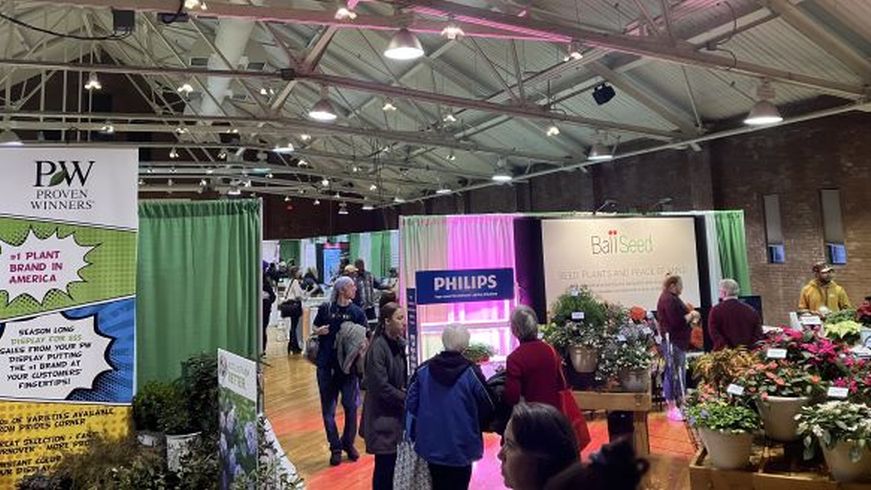A Look Back at the 2023 Northeast Greenhouse Conference

Photo: Ben Dillner
Note: This recap of the Northeast Greenhouse Conference, held in early November, was written by Ben Dillner, State Survey Coordinator of Vermont’s Department of Public Health and Agricultural Resource Management.
This November, I had the opportunity to attend the Northeast Greenhouse Conference held in Manchester, NH, on Nov. 8-9. This conference was attended by growers both big and small, Extension staff, university researchers, and those who serve the horticultural industry in Northeastern states. There were presentations on everything from beneficial insects to hydroponics to new perennial varieties. Alongside the talks, there was a vibrant trade show featuring wholesale nurseries, greenhouse manufacturers, IPM companies, and other industry vendors. This was my first time attending the conference and it was a very enriching couple of days; the following are some important takeaways.
IPM: A Focus on Biocontrol
As recently as a decade ago, beneficials or biocontrol was presented as more of a niche tool in commercial settings; something that only smaller organic growers were using. Now, biocontrol is mainstream. Several talks were dedicated to discussing new biocontrol strategies and trials of products.
There are a wide variety of products that fall under the bio umbrella currently: beneficials which include predatory organisms such as wasps that kill pests, biopesticides (microbes that attack pathogenic fungi), and biostimulants which are organic substances that promote plant growth. Biocontrol is a hot topic in horticulture; for good reason, too. Growers face a seemingly unending deluge of new invasive pests that want to damage their crops. Some of these pests like Thrips parvispinus have been shown to be resistant to traditional pesticides.
Biocontrol offers a more targeted approach to pests. There is also very little risk to workers, consumers, or the environment from biocontrol agents. Especially in greenhouse-grown produce, growers can avoid pesticide residue if they only use biocontrol. In the past, biocontrol products were costly and harder to obtain; now, many larger companies are producing them on a commercial scale. A biocontrol approach may ultimately be more cost effective if the beneficial organisms can establish/reproduce in the production greenhouses.
Native Plants: Very Popular!
Consumers are searching out and installing native plants in their landscape, and plants that attract pollinator species. Multiple presentations focused on growers taking advantage of this trend. While this is great news for our insects and birds, there are challenges. A common theme was that the demand for natives is actually outstripping the supply. We need many more plants propagated from local populations by local growers. Not all native plant species are the same genetically; joe-pye weed from Illinois is different than joe-pye weed in Vermont. Some farms and organizations address this by starting seed sharing groups that collect wild seeds in a sustainable manner to be grown out. Other plant breeders are developing cultivars of native species that are extra showy or hardy. These cultivars are good replacements for non-native and potentially invasive plants that provide far fewer resources for our beloved pollinators.
A Changing (Horticultural) Climate
Horticulture is a diverse and rapidly evolving industry. The conference highlighted some of the big challenges, but also some plant-based successes. With food insecurity increasing around the world, controlled environment agriculture offers the ability to produce quality food locally. Even in frigid New England, growers produce vegetables and berries all year round.
The horticulture industry is not without sustainability issues such as energy and plastic use. But new technology like LED grow lights and pots made from cow manure help reduce the environmental impact. There was a fascinating presentation about growing media (potting soil) made from wood that is a viable alternative to peat which is effectively a non-renewable resource. Similar to many industries, labor constraints are affecting horticulture in a major way. There is no simple solution to labor issues, but new technologies like A.I. and robotics can help meet some of these needs.
It is also important to note that horticulture is rapidly becoming a multicultural industry in the Northeast. The conference offered many sessions in Spanish, which improved access to important information and new innovations in the horticultural industry to the Spanish speaking attendees. This highlights the value of inclusivity for all individuals engaged in the industry from growers to marketing of products for a diverse customer base.
The horticulture field is highly innovative and appears to have a cautiously optimistic outlook. Interest in gardening, local food production, and houseplants is at an all-time high, especially here in Vermont. There will always be challenges: weather, invasive pests, inflation, labor but that is why events like the Northeast Greenhouse Conference are so important. We need to have a clear exchange of information between public researchers, industry vendors, and growers.









